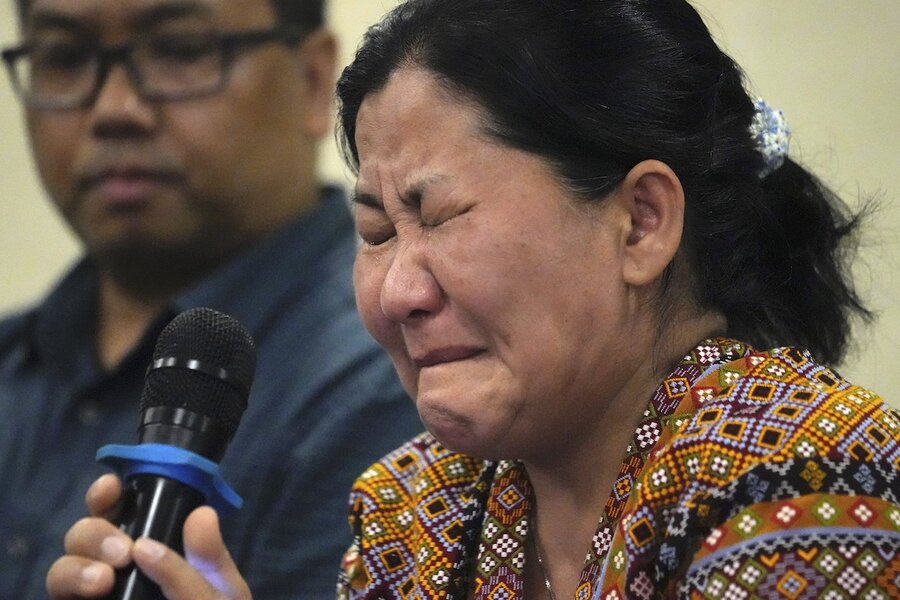Thousands have died under Myanmar’s military rule. Can a website help?
Loading...
| Bangkok
A group of human rights researchers officially launched a website Nov. 1 that they hope will help get justice for victims of state violence in Myanmar, where one of the world’s less-noticed but still brutal armed struggles is taking place.
Since the army seized power in February 2021 from the elected government of Aung San Suu Kyi, thousands of people have been killed by the security forces seeking to quash pro-democracy resistance. According to the United Nations, more than 1.8 million have been displaced by military offensives, which critics charge have involved gross violations of human rights.
War crimes have become easier to document in recent years thanks largely to the ubiquity of cellphone cameras and the near-universal access to social media, where photo and video evidence can easily be posted and viewed.
But it’s harder to establish who is responsible for such crimes, especially generals and other high-ranking officers behind the scenes who make the plans and give the orders.
“Generals and lower ranking officers should fear being dragged before a court of law and imprisoned for crimes they ordered or authorized,” Tom Andrews, the United Nations special rapporteur on the situation of human rights in Myanmar, told The Associated Press by email. “Research must move beyond merely stating the obvious – that crimes are occurring – and connect those who are responsible to specific atrocities. The victims of these crimes deserve justice and that will require the research necessary to hold those responsible fully accountable.”
The new website, myanmar.securityforcemonitor.org, is an interactive online version of a report, “Under Whose Command? – Human rights abuses under Myanmar’s military rule,” compiled by Security Force Monitor, a project of the Columbia Law School Human Rights Institute, to connect alleged crimes with their perpetrators.
The project’s team constructed a timeline of senior commanders and their postings, which can be correlated with documented instances of alleged atrocities that occurred under their commands. It exposes the army’s chain of command, identifying senior army commanders and showing the connections from alleged rights violations to these commanders, study director Tony Wilson told The AP in an email interview.
“This is one of the pieces of the jigsaw that has up until now been missing in terms of accountability – demonstrating how the system works and that these abuses are not just the result of rogue units or individual soldiers,” he said.
Mr. Wilson said the Myanmar data show that 65%, or 51 of all 79 senior army commanders between the end of March 2011 and the end of March this year, “had alleged disappearances, killings, rape, or instances of torture committed by units under their command.”
He said the study also shows the officer with the most links to serious human rights violations is Gen. Mya Htun Oo, who became defense minister and a member of the ruling military council when the army seized power in 2021. He also became deputy prime minister in 2023.
The legal significance leans on the established doctrine of “command responsibility,” which allows the prosecution under international law of military commanders for war crimes perpetrated by their subordinates. “We’ve applied lessons learned from researching militaries around the world to our work in Myanmar, and we would not have been able to map the Myanmar Army without those lessons” said Mr. Wilson.
“Establishing the command structures of militaries and other groups involved in atrocities is the lifeblood of properly conducting investigations into international crimes,” Mark Kersten, assistant professor of criminology and criminal justice at Canada’s University of the Fraser Valley, said in an email to The AP. “When the Nazis were prosecuted at Nuremberg, the lead counsel for the Allies famously exclaimed that it was individuals who would be prosecuted for atrocities, and not abstract entities, namely states.”
Collecting evidence of human rights violations in Syria’s civil war has served as a guide to utilizing online information and technical advances to gather and organize evidence of war crimes. Similar projects have also been launched in other areas of conflict including Sudan, Yemen, and Ukraine.
Since 2021, evidence-gathering groups have formed in Myanmar, including Myanmar Witness, an NGO that seeks to “collect, analyze, verify, and store evidence related to human rights incidents … in a way that is compatible with future human rights prosecutions.”
Similar work for Myanmar has already been done by groups documenting the security forces’ brutal 2017 counterinsurgency campaign in the western part of the country that drove an estimated 740,000 Rohingya to seek safety across the border in Bangladesh. Several international tribunals have been considering charges of genocide and other crimes brought against the army for their activities.
“Our work can complement and feed into the work of documenting abuses,” said Mr. Wilson. “Because we always aim to map the entire police or military, our research can help make connections between what human rights groups have documented and the wider chain of command.”
He said the project relied on open-source information drawn from the work of national and international human rights organizations and local activists, as well as books, independent newspapers, and the military’s own media outlets.
Its previous work includes research on the Mexican Army’s chain of command for a complaint to the International Criminal Court alleging crimes against humanity. Its methodology has been used to support the Syrian Archive’s submission of evidence to investigative and prosecute authorities in Germany, France, and Sweden about the 2013 sarin gas attack on Khan Shaykhun.
“We’ve applied lessons learned from researching militaries around the world to our work in Myanmar, and we would not have been able to map the Myanmar Army without those lessons,” said Mr. Wilson.
This story was reported by The Associated Press.







